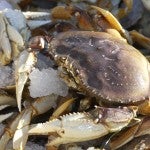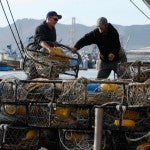
Fresh Dungeness crab catch of the day
California’s Dungeness crab fishery is one of the state’s largest and most important commercial fisheries and is an economic foundation for many of California’s ports. A bill recently passed by the California Legislature, SB 369 (Evans), that will cap the number of traps that individual fishermen can use. This will not only protect crab populations for generations to come, but will protect the economic viability of the fishery and the coastal communities that rely on it.
The problem is that the number of crab traps being used in the fishery escalates each season as fishermen race to catch crab. This “arms race” creates unnecessary ecological impacts and threatens the long-term economic health of the fishery. This frenzied derby effect leads to a glut of crab on the market at the beginning of the season and correspondingly depresses the value of crab. It also leads to significant safety risks as the intense pressure to compete during the initial weeks of the season can lead fishermen to go out in dangerous winter weather. This resulted in broad recognition among fishermen that trap limits are needed, but until now, agreement on what those limits should be could not be reached.

Bay Area crab fisherman preparing for the catch. Photo by Justin Sullivan/Getty Images News.
To help address this problem, Environmental Defense Fund was approached by a group of crab fishermen in 2008 to help sponsor a bill (SB 1690 – Wiggins) to create the Dungeness Crab Task Force. The group was charged with developing recommendations to the Legislature to address the challenges facing the fishery, including the “arms race.” It was comprised of an elected group of diverse fishermen from all major crab ports and representing both large and small boats. The group met during 2009 and 2010 and came to consensus on the design for a trap limit in the fishery.
The new law incorporates the recommendations of the Dungeness Crab Force. Fishermen are broken out into 7 “tiers” basedon how much crab they’ve landed in the past. Fishermen who have landed the most can fish with 500 traps and those who have historically landedthe least can fish with 175. The law also includes sufficient fees to cover all of the costs identified by the Department of Fish and Game (DFG) and was passed with bipartisan support by the Legislature. It’s supported by major fishing organizations such as the Pacific Coast Federation of Fishermen’s Associations and the Crab Boat Owners Association, as well as environmental groups such as EDF, the Sierra Club, and the Natural Resources Defense Council.
Let’s thank Governor Brown for passing SB 369 and helping to ensure the long term biological and economic sustainability of California Dungeness crab fishery, while at the same time promoting fishermen safety at sea.









